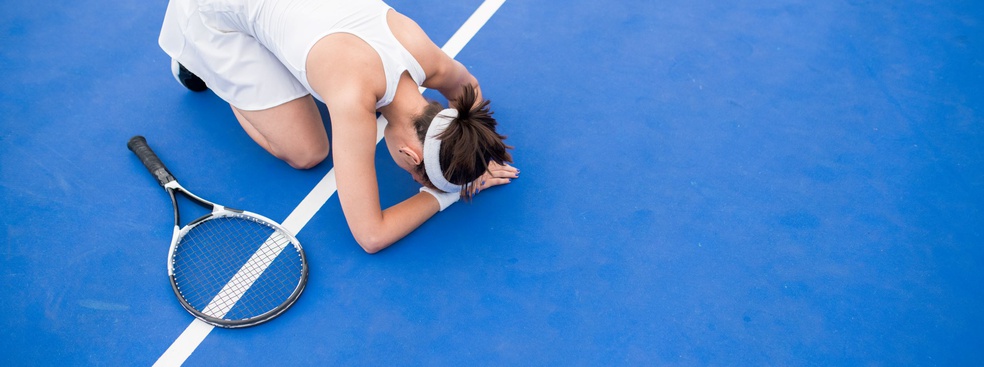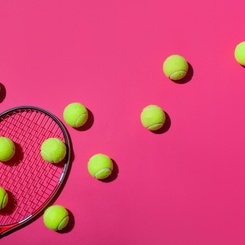With ESSEC Knowledge Editor-in-chief
Athletes’ mental health has been in the spotlight lately. Naomi Osaka withdrew from the French Open after she was fined for skipping a press conference to protect her mental health. Then, highly decorated US gymnast Simone Biles temporarily withdrew from the Olympics because she was struggling to cope with the stress and pressure. As prominent athletes speak out about their struggles with stress, anxiety, depression, and even burnout, public awareness of the importance of mental health in professional sport is perhaps higher than ever before.
We think of athletes as exceptionally resilient and tough. We see them get up after a fall or compete while injured, and excel under exceptional pressure and scrutiny. Yet research shows that professional athletes are just as likely as non-athletes to experience mental health issues (Rice et al., 2016; Gorczynski et al., 2017). One study analysed data from 22 different studies and found that around 34% of elite athletes reported symptoms of anxiety or depression, the most common mental health symptoms (Gouttebarge et al., 2019).
Being a professional athlete is often seen as a dream job. After all, you are getting paid to do something you love. In addition, sport is beneficial to mental health. Research, including my own, (Kelly et al., 2020), generally shows a positive link between sport and mental health indicators. Exercise can even be effective in alleviating symptoms of anxiety and depression. But these studies were conducted with recreational rather than professional athletes, and the latter face challenging demands and difficult working conditions that are often far from a dream scenario.
A job like no other?
Research shows that elite sport is more physically demanding than jobs in, for example, human services or technology (Balk et al., 2020), which comes as no surprise.. Elite sport is not only more physically demanding: it is also highly cognitively demanding. Professional athletes exert enormous cognitive effort as they attempt to improve their performance (Ericsson et al., 1993). They need to exercise concentration and precision, remember many things simultaneously, and make complex decisions (Balk et al., 2018). Importantly, athletes also face substantive emotional demands: they need to deal with emotions arising from unrealistic expectations, disappointment about their performance, negative feedback, and criticism (Balk et al., 2020). In addition to regulating their own emotions, athletes are also faced with the difficult emotions of others, such as angry spectators, team members, or coaches. In today’s connected era, they also face intense social media scrutiny, both positive and negative, that is immensely difficult to avoid. Even just witnessing other people’s unpleasant interactions can require regulating one’s emotions and leave people feeling drained (Totterdell et al., 2012). Having to suppress emotions can in turn impair sport performance (Wagstaff, 2014).
Athletes do not operate in a vacuum but within sports organizations. They experience many of the interpersonal difficulties we may face in the workplace, like team conflict or a difficult relationship with a superior. In fact, athletes often consider the organization as more stressful than training or competition. (Arnold et al., 2016). Issues related to leadership and personnel, the culture and the atmosphere between the team, and logistics and finances are pervasive.(Arnold and Fletcher, 2012).
While top athletes with lucrative sponsorship deals and high profile players in professional leagues may not worry about their finances, many athletes are facing insecure funding and may have part-time jobs to support themselves. Even in the US, the country leading the Tokyo 2020 medal table, in which the sports ecosystem is highly developed, the majority of athletes are not raking in money: Forbes reports that around 60% of US athletes who competed in Tokyo earn less than $25 000 per year.
Naturally, conditions vary across sports, and for athletes in team-based sports, the logistics of travel, training, and competition can be more complex and cumbersome than for individual sports (Arnold et al., 2016). Logistics outside their control are an issue even for highly resourceful athletes such as professional football players. A report by FIFPRO highlights that many elite players do not have sufficient time to recover between matches. For example, elite non-European players (whose national teams are based on a different continent from the club they play for) travel across time zones to compete. In a 2018 FIFPRO survey, 60% of players reported a negative impact of flights on their recovery.
In addition, athletes are increasingly aware of the need to develop and promote their personal brand. Social media is a powerful tool for athletes to develop their relationship with fans and corporate sponsors, yet it also poses a new set of challenges. Being permanently connected to fans and sponsors on social media prevents athletes from mentally disconnecting from their “job”. This can prevent them from psychologically recovering from the demands they face, making it more likely that high stress levels impact their mental health (Sonnentag and Fritz, 2015). Social media can also expose athletes to online abuse. This is particularly true for athletes who are people of colour or women. The racist abuse on social media faced by England’s Black players following the team’s defeat at the UEFA EURO 2020 provided a recent chilling example. A BBC Sport survey found that a third of female elite British athletes face abuse on social media, including comments about their appearance. While athletes thirty years ago could retreat from the public eye with relative ease, this is more challenging for today’s athletes.
Resources can buffer demands
As in other professions, resources can protect athletes from the impact of the demands they face on their mental health (Balk et al., 2018). Two types of resources are particularly important. First, a sense of autonomy and control can protect an athlete’s mental health. This can mean having control over the physical demands placed upon their body, such as being able to take breaks or decide how hard to push in a training session, or participating in training decisions. A sense of control of the important decisions in their life directly affects athletes’ mental health and can shelter them from the impact of demands.
Emotional support similarly protects athletes’ mental health. For example, in a study of 130 high level British tennis players, researchers found that having someone who will listen to them and to whom they can vent freely buffered the negative effect of competition pressure (Rees and Hardy, 2004).
When demands outweigh resources: Athlete burnout
As in all jobs, when the demands athletes face outweigh the resources available to them to cope with these demands (Smith, 1986), other mental health issues develop, potentially resulting in burnout. Little is known about how many athletes may suffer from burnout resulting from the chronic high levels of stress they face, with some estimating that between 1% and 9% of athletes are experiencing some level of burnout (Gustafsson et al., 2007).
Much like burnout in other professions, athlete burnout is first and foremost about a deep sense of emotional and physical exhaustion (Gustafsson et al., 2017). When Dutch cyclist Tom Dumoulin withdrew from the Vuelta a Espana in 2020, he described feeling empty and having no energy, a persistent feeling of fatigue that would not go away. Beyond this feeling of exhaustion, athletes experiencing burnout also question their own abilities and achievements and develop a sense of cynicism towards their sport. Speaking to the BBC in 2018, British cycling gold medallist Elinor Barker said “I was exhausted and I didn’t really want to ride my bike; in the eight years I’d been riding it was the first time […] and it was such an alien feeling.” Both athletes recovered and came away from Tokyo with medals. Yet some athletes experiencing burnout withdraw from sport completely (Gustafsson et al., 2018), resulting in a loss of talent for the sport.
Risk factors - Why do some struggle more than others?
A number of factors put athletes at risk of experiencing mental health issues. First, there are periods in an athlete’s career when their mental health is particularly at risk, such as periods of injury, performance slumps, or retirement from professional sport. Some personality characteristics can also predispose athletes for mental health issues. Athletes are particularly at risk if they tend to worry about making mistakes and about being judged by others, and to feel extremely stressed, frustrated, or angry if they do not fulfil their own high expectations (Hill and Curran, 2016).
Defining themselves exclusively in terms of their identity as an athlete is another risk factor. Having no clear sense of who they are outside of sport puts athletes at risk of mental health issues such as burnout (Coakley, 1992). At the ESSEC Sports Chair, we are developing a tool that helps athletes think of themselves as a whole person as they navigate their career and prepare for the future, with the aim of protecting athletes’ mental health, particularly in the face of setbacks and transitions.
Barriers to seeking help
In the light of increasing awareness of athletes’ mental health issues, governance bodies are signalling their commitment to protecting athletes’ mental health. The International Olympic Committee has released guidance to support stakeholders in the sports ecosystem in protecting and promoting the mental health of athletes, and the IOC’s Athletes’ Rights and Responsibilities declaration explicitly advocates the protection of both physical and mental health. Yet despite these efforts, research suggests that athletes are less likely to admit to, or seek help for, mental health symptoms than members of the public (Kaier et al., 2015). Athletes are celebrated for their mental toughness, their capacity to perform consistently well even under adversity (Gucciardi et al., 2015). Young athletes are taught to deal with pain and minor injuries by “shaking them off” and “toughing them out” (Malcom, 2006). When, for example, competing while injured is seen as a sign of courage and bravery, athletes denying their humanity becomes something to be celebrated. When toughness is praised, seeking help may be seen as implying weakness. This celebration of toughness may inadvertently contribute to the stigma athletes experience when seeking support for mental health issues (Poucher et al., 2021). “Powering through” like this can be dangerous not only for mental health, but also physical health: Simone Biles reported experiencing “the twisties” during the Olympics, where gymnasts lose spatial awareness, which can lead to serious injuries if not attended to. The stigma associated with mental health issues can prevent athletes from seeking help early when problems can be more easily remedied, and it also means that studies may be underestimating how many athletes are affected.
How prominent athletes can help destigmatise mental health issues – at a cost
The economic costs of mental health issues exceed those of all other categories of noncommunicable disease, including cardiovascular diseases and cancer (Bloom et al., 2011). The COVID-19 pandemic has only exacerbated this issue: an estimated 28.0% of the global population have experienced symptoms of depression and 26.9% have suffered from anxiety (Nochaiwong et al., 2021). While some research shows that the stigma of mental health issues and receiving psychological help has decreased over the past few decades (Angermeyer et al., 2014), this varies enormously between different cultures and communities (Zhou et al., 2019). Destigmatising mental health issues is a global concern, and athletes speaking openly about their mental health can play an important role in reducing the stigma. Initiatives such as the State of Mind campaign of Australia’s National Rugby League collaborate with high profile athletes to educate the public about mental health issues and reduce the stigma. Such campaigns potentially have a particularly crucial role to play by addressing men, who are far less likely than women to seek help for mental health issues (Addis and Mahalik, 2003).
Popular athletes speaking out about their struggles with mental health use their platform to benefit others and to change the public perception of mental health issues. Yet being in this position also means that athletes who are already in a vulnerable situation now face the additional burden of being a spokesperson, not necessarily by choice. Writing for Time Magazine in July 2021, Naomi Osaka explained that she felt under enormous pressure to open up about her mental health symptoms.
While there has been a lot of public support, athletes speaking out also face negative comments. British swimmer Adam Peaty who won the 100m breaststroke in Tokyo announced that he was taking a break to protect his mental health and then commented on social media that the comments he received in response were “why we have such a stigma around mental wellbeing in sport”.
Over the last few years, and especially this summer, we’ve seen increasing awareness of the mental health challenges athletes face, thanks in no small part to prominent athletes being willing to open up. Sporting bodies are starting to react by putting measures in place to protect mental health, but the lack of widespread measures and intense social media backlash faced by athletes who disclosed their challenges show that there is work to be done. Mental health challenges impact all of us, and athletes are not spared from this: moving forward, improving support and resources for elite athletes needs to be an essential component of their working conditions.
Interested in learning more about athlete mental health? Join the ESSEC Sports Chair in a discussion with a panel of experts on October 14th at 8:15am (Paris time). Sign up here.
References
Addis ME and Mahalik JR. (2003) Men, masculinity, and the contexts of help seeking. American Psychologist, 58: 5-14.
Angermeyer MC, Matschinger H, Carta MG, et al. (2014) Changes in the perception of mental illness stigma in Germany over the last two decades. European Psychiatry, 29: 390-395.
Arnold R and Fletcher D. (2012) A research synthesis and taxonomic classification of the organizational stressors encountered by sport performers. Journal of Sport and Exercise Psychology, 34: 397-429.
Arnold R, Fletcher D and Daniels K. (2016) Demographic differences in sport performers’ experiences of organizational stressors. Scandinavian Journal of Medicine & Science in Sports, 26: 348-358.
Balk YA, De Jonge J, Oerlemans WGM, et al. (2020) “What a match!”: The specific role of resources in the relation between demands and vigour in elite sport. Applied Psychology, 69: 120-147.
Balk YA, De Jonge J, Oerlemans WGM, et al. (2018) Balancing demands and resources in sport: Adaptation and validation of the demand-induced strain compensation questionnaire for use in sport. Journal of Sports Science & Medicine, 17: 237-244.
Bloom DE, Cafiero ET, Jané-Llopis E, et al. (2011) The global economic burden of noncommunicable diseases, Geneva: World Economic Forum.
Coakley J. (1992) Burnout among adolescent athletes: A personal failure or social problem? Sociology of Sport Journal, 9: 271-285.
Ericsson KA, Krampe RT and Tesch-Römer C. (1993) The role of deliberate practice in the acquisition of expert performance. US: American Psychological Association, 363-406.
Gorczynski PF, Coyle M and Gibson K. (2017) Depressive symptoms in high-performance athletes and non-athletes: A comparative meta-analysis. British Journal of Sports Medicine, 51: 1348.
Gouttebarge V, Castaldelli-Maia JM, Gorczynski P, et al. (2019) Occurrence of mental health symptoms and disorders in current and former elite athletes: a systematic review and meta-analysis. British Journal of Sports Medicine, 53: 700.
Gucciardi DF, Hanton S, Gordon S, et al. (2015) The concept of mental toughness: Tests of dimensionality, nomological network, and traitness. Journal of Personality, 83: 26-44.
Gustafsson H, DeFreese JD and Madigan DJ. (2017) Athlete burnout: Review and recommendations. Current Opinion in Psychology, 16: 109-113.
Gustafsson H, Kentt Gr, Hassman P, et al. (2007) Prevalence of burnout in competitive adolescent athletes. The Sport Psychologist, 21: 21-37.
Gustafsson H, Madigan D and Lundkvist E. (2018) Burnout in athletes. In: Fuchs R and Gerber M (eds) Handbuch Stressregulation und Sport. Berlin, Heidelberg: Springer, 489-504.
Hill AP and Curran T. (2016) Multidimensional perfectionism and burnout: A meta-analysis. Personality and Social Psychology Review, 20: 269-288.
Kaier E, Cromer LD, Johnson MD, et al. (2015) Perceptions of mental illness stigma: Comparisons of athletes to nonathlete peers. Journal of College Student Development, 56: 735-739.
Kelly CM, Strauss K, Arnold J, et al. (2020) The relationship between leisure activities and psychological resources that support a sustainable career: The role of leisure seriousness and work-leisure similarity. Journal Of Vocational Behavior, 117: 103340.
Malcom NL. (2006) “Shaking it off” and “toughing it out”: Socialization to pain and injury in girls’ softball. Journal of Contemporary Ethnography, 35: 495-525.
Nochaiwong S, Ruengorn C, Thavorn K, et al. (2021) Global prevalence of mental health issues among the general population during the coronavirus disease-2019 pandemic: a systematic review and meta-analysis. Scientific Reports, 11: 10173.
Poucher ZA, Tamminen KA, Kerr G, et al. (2021) A commentary on mental health research in elite sport. Journal of Applied Sport Psychology, 33: 60-82.
Rees T and Hardy L. (2004) Matching social support with stressors: Effects on factors underlying performance in tennis. Psychology of Sport and Exercise, 5: 319-337.
Rice SM, Purcell R, De Silva S, et al. (2016) The mental health of elite athletes: A narrative systematic review. Sports Med, 46: 1333-1353.
Smith RE. (1986) Toward a cognitive-affective model of athletic burnout. Journal of Sport and Exercise Psychology, 8: 36-50.
Sonnentag S and Fritz C. (2015) Recovery from job stress: The stressor-detachment model as an integrative framework. Journal Of Organizational Behavior, 36: S72-S103.
Totterdell P, Hershcovis MS, Niven K, et al. (2012) Can employees be emotionally drained by witnessing unpleasant interactions between coworkers? A diary study of induced emotion regulation. Work & Stress, 26: 112-129.
Wagstaff CRD. (2014) Emotion regulation and sport performance. Journal of Sport and Exercise Psychology, 36: 401-412.
Zhou Y, Lemmer G, Xu J, et al. (2019) Cross-cultural measurement invariance of scales assessing stigma and attitude to seeking professional psychological help. Frontiers in Psychology, 10.



